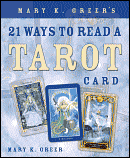
Reading 21 Ways to Read a Tarot Card is like taking a personal workshop from Mary Greer, who probably knows more about the history, theory, and practice of the tarot than anyone else on the planet. “Pick a card,” she begins. Find a deck whose minor arcana cards have pictures on them, relax into your meditative state, shuffle the cards, and select three cards. Which appeals most to you? That’s the card you’ll work with. You can be a master tarot reader or a beginner, you can be reading for a querent or yourself—after you complete this course of study, you’ll be able to take what you’ve learned and apply your knowledge to the rest of the cards in the deck. (Which is a good idea.) By the time you’ve finished the activities in Step 21, you’ll have progressed beyond mere theory and entered the land of opportunity, ritual, and real work in your real life.
Each of the twenty-one steps is the subject of a chapter that includes things to actually do. You’re not just sitting there and reading a book. You’re getting into the tarot. Step 1: name the card. Say the name of the card out loud. Saying the name out loud establishes a connection between you and the card. Step 2: describe the card. What’s in the picture? What details do you see? What do they mean to you? Step 3: what emotions do you project into the card or are suggested by the card? Step 4: tell a story about the card. Make it a myth or fairy tale, and, Greer advises, “be spontaneous, wild and a little crazy” in telling your story. Let animals and inanimate objects speak. The story doesn’t have to make sense, Greer adds, because as we follow the twenty-one steps we’re following the path of the Fool, which—yes, indeed—does not always make sense. Step 5: what is the symbolism of the card’s number? (Greer presents a mini-course in numerology.) Step 6: what do the card’s mode, suit, and elemental correspondences signify? After we synthesize what we’ve learned so far (Step 7), we step through the gate to the path of deeper knowledge.
The chapters include sections titled “The Way of the Apprentice,” which is the basic, introductory material, and “The Way of the Adept,” in which we listen to someone who knows the theory behind what she teaches. We already know, for example, that stories have enormous power; here we also learn what that power can be and how the picture on a tarot card can have correspondences with our lives, how we may act them out in our lives. In Step 18, we imagine ourselves inside the card and Greer provides a guided visualization. We become a character drawn on the card, feel the card’s archetypal energies, speak with or listen to a character on the card. Imagine hearing what the Empress or the Hanged Man might say. What would it feel like to ride in the Chariot? To fall out of the Tower or travel under the Moon?
The book also includes nine appendixes and a glossary. This may be the only book you’ll really need on the tarot. All the other books are, so to speak, icing on the cake baked by Mary K. Greer.
~review by Barbara Ardinger, Ph.D.
Author: Mary K. Greer
Llewellyn Publications, 2006
